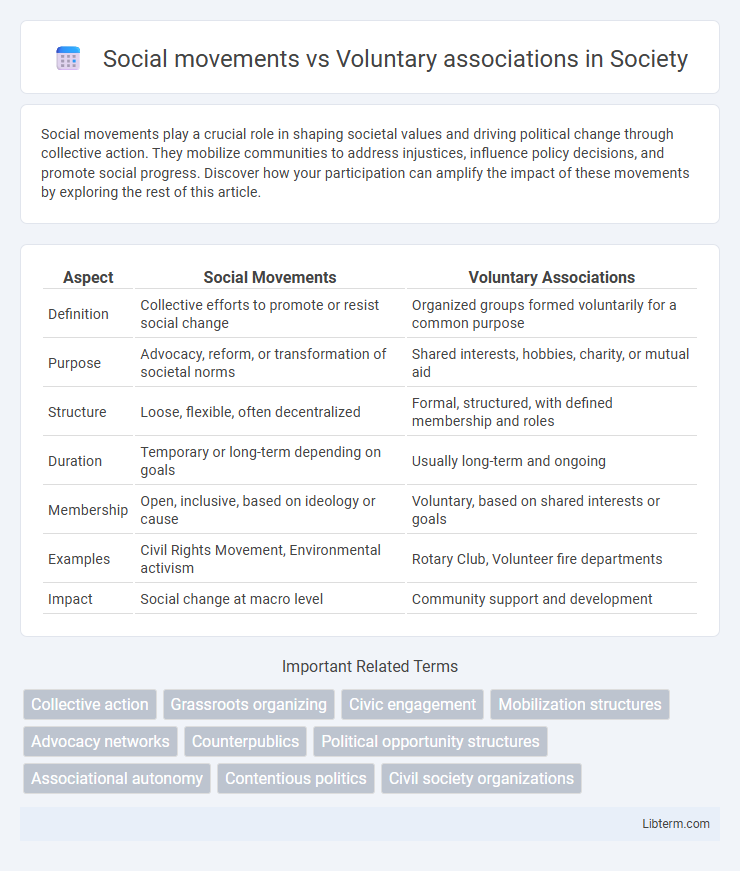Social movements play a crucial role in shaping societal values and driving political change through collective action. They mobilize communities to address injustices, influence policy decisions, and promote social progress. Discover how your participation can amplify the impact of these movements by exploring the rest of this article.
Table of Comparison
| Aspect | Social Movements | Voluntary Associations |
|---|---|---|
| Definition | Collective efforts to promote or resist social change | Organized groups formed voluntarily for a common purpose |
| Purpose | Advocacy, reform, or transformation of societal norms | Shared interests, hobbies, charity, or mutual aid |
| Structure | Loose, flexible, often decentralized | Formal, structured, with defined membership and roles |
| Duration | Temporary or long-term depending on goals | Usually long-term and ongoing |
| Membership | Open, inclusive, based on ideology or cause | Voluntary, based on shared interests or goals |
| Examples | Civil Rights Movement, Environmental activism | Rotary Club, Volunteer fire departments |
| Impact | Social change at macro level | Community support and development |
Defining Social Movements: Core Characteristics
Social movements are collective efforts driven by a shared desire for social or political change, characterized by organized, sustained actions that challenge existing norms or policies. They often emerge from grassroots mobilization and rely on symbolic communication, collective identity, and a sense of solidarity among participants. Unlike voluntary associations, which are formal groups with structured membership and goals, social movements are fluid, loosely organized, and focus on broader societal transformation.
Understanding Voluntary Associations: Key Features
Voluntary associations are organized groups formed by individuals who share common interests or goals, operating voluntarily without coercion. These groups emphasize structured membership, ongoing participation, and collective decision-making to achieve specific social, cultural, or recreational objectives. Unlike social movements, voluntary associations maintain formal organization and sustained activities rather than spontaneous or transient collective action.
Historical Origins of Social Movements and Voluntary Associations
Social movements trace their historical origins to collective efforts aimed at systemic social or political change, often emerging during periods of upheaval such as the 19th-century labor and civil rights movements. Voluntary associations originated earlier with roots in local community and religious groups from the 18th century, emphasizing social bonds and mutual aid rather than broad societal reform. These distinct origins highlight social movements as catalysts for large-scale transformation, while voluntary associations focus on organized, voluntary community engagement and support.
Goals and Objectives: Distinguishing Factors
Social movements pursue broad social or political change, aiming to transform cultural norms, policies, or power structures through collective action and sustained public engagement. Voluntary associations focus on specific, defined objectives such as providing community services, advocacy for particular interests, or fostering social networks without necessarily seeking systemic societal change. The primary distinction lies in social movements' emphasis on large-scale societal impact versus voluntary associations' targeted and organizationally structured goals.
Organizational Structure and Leadership
Social movements typically have fluid, decentralized organizational structures that emphasize collective action and grassroots participation, whereas voluntary associations often maintain formal hierarchies with defined roles and established governance systems. Leadership in social movements tends to be distributed or emergent, driven by shared goals and spontaneous mobilization, while voluntary associations rely on elected or appointed leaders who manage ongoing activities and organizational stability. The contrast highlights the dynamic, adaptive nature of social movements compared to the structured, institutional framework of voluntary associations.
Methods of Mobilization and Participation
Social movements employ collective action through protests, demonstrations, and digital campaigns to mobilize broad public participation and challenge social norms. Voluntary associations rely on formal membership structures, regular meetings, and organized activities to engage participants in sustained, cooperative efforts. Participation in social movements tends to be more fluid and episodic, while voluntary associations emphasize ongoing commitment and institutional involvement.
Social Impact and Influence on Policy
Social movements drive widespread social change by mobilizing large groups to challenge existing norms and influence policy reforms on issues like civil rights, environmental protection, and social justice. Voluntary associations, often smaller and more structured, contribute to social impact through sustained community engagement, advocacy, and direct service provision, which can indirectly shape policy over time. Both play crucial roles in shaping public discourse and legislative agendas, yet social movements typically generate rapid, large-scale policy shifts while voluntary associations maintain long-term influence through institutional relationships.
Membership Dynamics: Recruitment and Retention
Social movements often experience fluctuating membership driven by high levels of activism and issue salience, relying on emotional appeal and shared grievances to recruit participants quickly. Voluntary associations maintain more stable membership through structured benefits, consistent engagement, and formal recruitment strategies, emphasizing long-term commitment. Retention in social movements depends on sustained political opportunities and collective identity, while voluntary associations focus on member satisfaction and organizational loyalty.
Challenges and Obstacles Faced
Social movements often face challenges such as rapid mobilization difficulties, sustaining collective identity, and confronting institutional opposition that seeks to suppress or co-opt their agendas. Voluntary associations encounter obstacles including member recruitment and retention, funding constraints, and bureaucratic limitations that can hinder effective organization and long-term sustainability. Both entities struggle with maintaining motivation and coherence amid external pressures and internal conflicts.
Collaboration, Conflict, and Interactions Between Social Movements and Voluntary Associations
Social movements and voluntary associations often collaborate to amplify social change efforts, leveraging the grassroots mobilization of social movements and the organizational resources of voluntary associations. Conflicts can arise due to differing priorities, strategies, or leadership structures between the spontaneous activism of social movements and the institutional frameworks of voluntary associations. Interactions between these entities shape public policy and social norms by combining protest-driven pressure with sustained advocacy and service provision, creating dynamic partnerships that influence societal transformation.
Social movements Infographic

 libterm.com
libterm.com